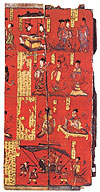Questions on the Reading
|
Week 9
|
|
 |
 |

|

|
|
|
| Questions on the Reading for week 9 |
| |
|
Sources of Chinese Tradition, pp.800-840.
Sources of Korean Tradition, pp.293-306, 313-326 *
Sources of Japanese Tradition, pp.399-412, 420-432.
* Religions of Japan in Practice, pp. 44-52. |
| |
|
Introduction to "Neo-Confucianism in Late Imperial
China, Korea, and Japan."
As imperial patronage of Buddhism waned, monks were replaced with
Confucian scholars in diplomatic exchanges, and sutras with Confucian
texts. When Zhu Xi's commentaries on the Confucian canon were adopted
in 1241 as the standard interpretation for the imperial examinations
in China, Korean scholarship followed suit. Later trends in Neo-Confucian
scholarship were equally debated by Chinese, Korean, and Japanese
scholars alike.
But communications between China, Korea, and Japan were not confined
to diplomatic and scholarly exchanges. From the middle of the thirteenth
century through the middle of the fourteenth century, the Mongols
built an empire of unprecedented proportions that stretched from
Eastern Europe to Korea (two naval expeditions to Japan failed,
in 1274 and 1281), thereby creating new trade routes and new diplomatic
relations. In the late sixteenth century, the Japanese general Toyotomi
Hideyoshi (1536-1598) not only battled scores of feudal lords in
order to unify the Japanese empire, but he sought to conquer the
Ming empire (1368-1644). The resulting Imjin wars (1592-1598, in
which Ming imperial armies were dispatched at great cost to support
Korean troops in resisting the Japanese invasions) destroyed Korean
agriculture and commerce, and contributed to the fall of the Ming
dynasty. During the sixteenth century, European nations began to
stake claims in East Asia, and thus began the integration of East
Asia into an increasingly complex world economy.
|
| |
 |
Filial sons and virtuous women of antiquity. Panel from a
wooden screen painted in lacquer. From a tomb dated 484 at
Datong, Shanxi. Northern Wei Dynasty.
|
|
| |
| Questions |
|
- What differences and similarities do you perceive between Buddhism
and Neo-Confucianism in their development over time and in their
adoption and adaptation throughout East Asia?
- How does the "Neo-Confucian East Asia" differ from
the "Buddhist East Asia" in its conception of body,
space (buildings, landscape), gender, family, state, national
identity, and "East Asia"? How do the detailed admonitions
about body, gender, and family in the admonitions for women and
in Yi Hwang's writings relate to the larger context of Confucian
and Neo-Confucian texts?
- How do Oda Nobunaga, Toyotomi Hideyoshi, and Tokugawa Ieyasu
legitimize their government and their policies? How do they view
their territory, their subjects, and other countries?
|
|